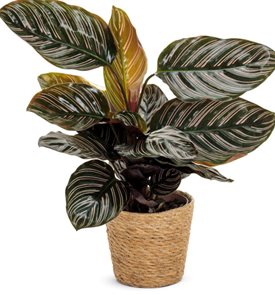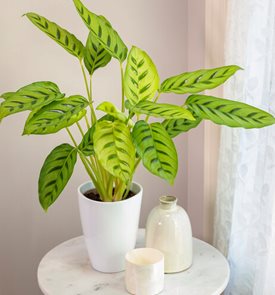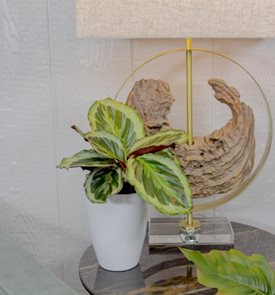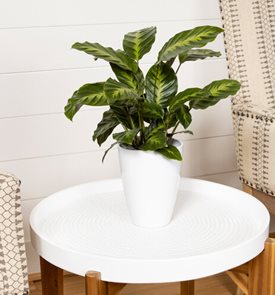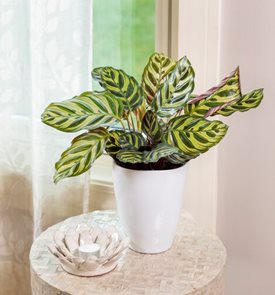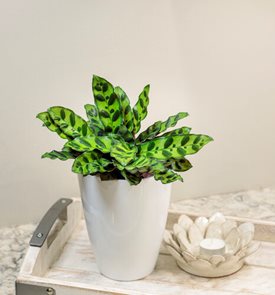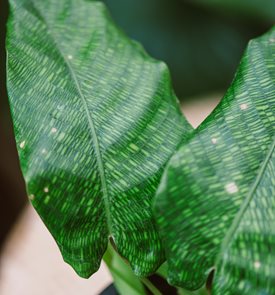A GUIDE TO GROWING CALATHEA PLANTS
Liven up indoor spaces with these colorful easy-to-grow houseplants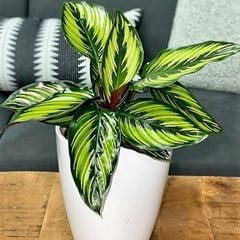
Color Full® Beauty Star pinstripe calathea. Photo by: Proven Winners
Calathea is a popular indoor plant grown for its highly decorative foliage that comes in an assortment of eye-catching patterns, colors, and shapes. These versatile tropical plants thrive in medium to low light, making them a good choice for indoor environments.
Though it has a reputation for being somewhat fussy, calathea plants are actually easy to grow when given the right conditions. In addition to being highly decorative, they are one of the best plants for cleansing indoor air of harmful pollutants. With so many species of calathea to choose from, this attractive houseplant will complement any home or office decor.
On this page: Basics | Growing Tips | Plant Care and Maintenance | Calathea Pictures | Toubleshooting | Display Ideas
CALATHEA BASICS
Botanical name:
Calathea spp.
Common names:
Prayer plant, rattlesnake plant, zebra plant, cathedral plant, peacock plant
Origin:
Native to tropical forests of South America
Zones:
USDA Zones 11-12. Plants will grow outdoors in frost-free regions of Florida and Hawaii.
Care level:
Easy to moderate
Light requirements:
Calathea plants prefer bright indirect window light. Direct sunlight can cause leaves to burn or fade. Calathea is tolerant of low light, though markings will be less distinct. (See more low-light houseplants.)
Growth rate:
Moderate to fast, depending on the variety and growing conditions.
Foliage:
Leaves up to 12 inches long are oval, pointed, or lance-shaped in shades of green or purple, some with burgundy or purple undersides. Spotted or striped patterns occur in hues of silver, pink, yellow, or cream. The leaves move in response to light, folding up at night and opening wider during the day, hence the common name of prayer plant.
Flowers:
When grown as an indoor houseplant, blooms are scant or non-existent. Small lily-like flowers grow from the base of the plant during summer in colors of purple, pink, white, yellow or orange.
Habit and size:
Upright habit, 6 to 36 inches tall and 6 to 24 inches wide
Toxicity:
Though all parts of the calathea plant are safe for pets and children, consumption is not recommended. Mild stomach distress can occur when any plant is ingested. See more Common Plants Safe for Cats and Dogs.
Calathea lookalikes:
Calathea is classified in the family Marantaceae and related to prayer plant (Maranta), which has similar foliage. Zebra plant (Calathea zebrina) shares the same common name with Aphelandra squarrosa, which also has a striped leaf pattern.
CALATHEA GROWING TIPS
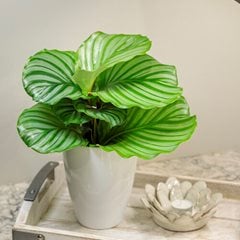
Color Full® Orbifolia. Photo by: Proven Winners
Where to grow:
Site in a draft-free area near a window that receives bright indirect light.
Temperature:
Calathea thrives in conditions that simulate its native tropical habitat. Ideal temperatures are between 65-85 degrees F. Plants will stop growing or suffer damage if temperatures dip below 55-60 degrees F for an extended time.
Humidity:
Calathea prefers moist air between 50-80 percent humidity. Place plants in a bathroom or increase room humidity by using a humidifier, misting the leaves, or by setting pots on a tray of pebbles filled with water. Don’t allow the bottom of the pot to sit in water to prevent root rot.
Soil type:
Use a high quality potting mix that is well-draining. Calathea prefers a slightly acidic pH of around 6.5.
Pot requirements:
Grow in a pot with adequate drainage holes that is no more than 1 to 2 inches wider than the root ball, which will help prevent root rot.
CALATHEA CARE AND MAINTENANCE
Watering:
Water regularly, as Calathea plants like moist soil, but not wet. Allow the top inch of soil to dry out between waterings; overwatering can cause root rot. Discard excess water from the saucer underneath the pot so that plants are not sitting in water.
Fertilizing:
Apply a liquid houseplant fertilizer monthly at half-strength, ceasing during winter months when growth slows down.
Pruning:
Trim brown or yellow leaves back to the base of the plant to encourage healthy new growth.
Cleaning:
Wipe leaves with a damp cloth every few months to keep foliage looking fresh.
Repotting:
Calathea don’t like their roots disturbed, so repot only if root bound. Repot in early spring before plants resume growing and increase pot size by no more than 1 to 2 inches wider than the root ball to prevent root rot. Use fresh potting mix and don’t disturb roots. Water lightly after transplanting and avoid fertilizing for 4 to 6 weeks.
Pests:
Small flying insects may indicate the presence of fungus gnats. Though they are harmless to plants, they can be a nuisance. Decrease soil humidity, which attracts gnats, by bottom watering to leave soil surface dry. Diatomaceous earth mixed into the top layer of soil will also deter gnats.
Other pests can include spider mites, mealybugs, thrips, or scale. Wipe affected foliage with a cloth dipped in 70% rubbing alcohol, or spray with an insecticidal soap. (See more on how to get rid of pests on houseplants)
CALATHEA VARIETIES
See more Color Full® calatheas from the leafjoy® line from Proven Winners.
TROUBLESHOOTING
Most problems with calathea are due to watering issues, improper temperature or low humidity. Look for these possible symptoms:
- Brown or wilted leaf edges can occur with underwatering, dry air, or mineral buildup in the soil. Increase watering or humidity accordingly. Flush soil to rinse out minerals or repot in fresh soil. Switch to distilled or filtered water.
- Yellow leaves or brown leaf tips may happen if water contains too many chemicals or minerals. Use distilled, purified or rain water, or leave tap water sitting overnight to allow chlorine to evaporate.
- Curling leaves can be a sign that temperatures are too hot or cold, plants are underwatered, or air humidity is too low. Make sure room temperature is between 65-85 degrees F and increase water and humidity as needed.
- Faded or burned leaves indicate that plants are receiving too much light. Move out of direct sunlight.
- Yellowing of lower leaves, brown leaf edges or wilting leaves can occur after transplanting. Keep plants in an optimal environment and allow them time to recover.
- Yellow leaves can be a sign of overwatering or too much fertilizer. Adjust conditions accordingly and repot if there are signs of root rot.
DISPLAY IDEAS
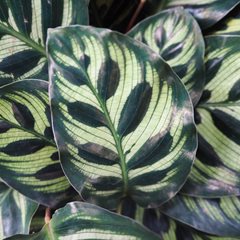
Peacock plant. Photo by: Voravuth sompaiboon / Shutterstock
- Place a medium-sized variety on a plant stand next to your bed to receive nighttime air cleansing benefits.
- Adorn a kitchen counter with a smaller specimen to enjoy while cooking or cleaning. The plant will benefit from the extra room humidity.
- Place a small specimen in a bathroom on a counter or in a plant hanger where it will benefit from the high humidity.
- Group several large specimens together as a floor display in an office lobby or home entry.
- Space several small potted calatheas in a single row along the center of a long dining room or boardroom table.
- Set a small to medium-sized plant on a desktop or shelf to brighten up your work environment.
RELATED:
21 Best Indoor Plants
Best Low-Light Houseplants
A Guide to Growing Peace Lily
A Guide to Growing Pothos
